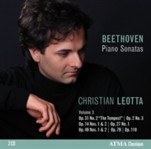Do you like cold, calculated and utterly charmless Beethoven playing? Then you’ll find a kindred spirit in Christian Leotta. Go to Op. 14 No. 1, where Beethoven’s poignant lyrical sensibility turns bleak and “downbeat oriented,” while the lilting Allegretto emerges as an Adagio autopsy. True, Richter took this movement just as slowly (wrongly so, in my opinion), yet at least he didn’t pound out the melodies. The “Tempest” sonata’s overly clipped, doggedly square and militant finale is one of the ugliest interpretations of this music I’ve ever encountered. Similarly, Leotta pokes the Op. 14 No. 2 slow movement’s detached chords with a stick, rather than voicing them with his fingers. Op. 27 No. 1 fares much better, despite a lack of spontaneity characterized by the pianist’s outsized dynamics and tiny breath pauses. Genuine animation and flow distinguish Op. 49 No. 2’s first movement, only to be sabotaged by the exaggeratedly drawn-out Tempo di menuetto. However, Leotta’s deliberate, hyper-detailed Op. 49 No. 1 held my interest and convinced me….temporarily, at least!
Despite moments of studied phrasing, the little, unpretentious Op. 79 manages to stay afloat. Op. 2 No. 3’s surface bravura boasts impressive sheen and symmetry, and unimpressive emotional detachment, as if each phrase had been dissected, put back together, and freeze-dried. Op. 110 is hardly the warmest, most communicative version out there, yet the first movement’s often-cloudy left hand figurations are uncommonly clear, while the fugue builds on a grand scale, albeit with a dragging Arioso. One must give Leotta credit for having the means to transform his conceptions into sound, with no evidence of a barrier between brain and fingers. But are these Beethoven’s conceptions and sounds?
































